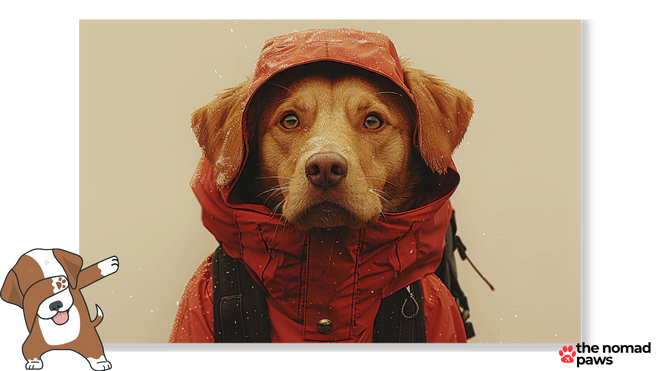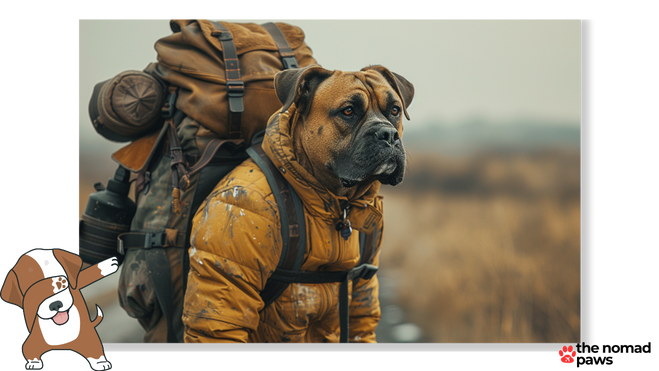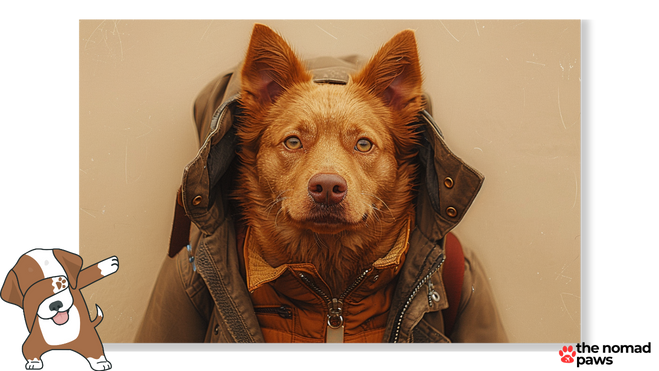When you’re an adventurous dog owner, you’ll want to bring your furry friend along on all your outdoor excursions. But what if your large dog isn’t up for the challenge or gets tired halfway through?
That’s where a dog backpack comes in handy. It’s a safe and comfortable way to carry your big dog when the terrain gets tough or the weather takes a turn.
Before you invest in one, there are some important factors to ponder to guarantee the best experience for both you and your canine companion.
Are Dog Backpacks Safe and Comfortable?
When considering a backpack for your large dog, safety and comfort should be top priorities.
It’s important to choose a backpack that fits your dog properly, with straps that distribute weight evenly and don’t chafe or restrict movement.
Additionally, the backpack should be made from durable, breathable materials to keep your dog cool and comfortable during walks or hikes.
Safety
Dog backpacks are generally safe and comfortable for your pet, provided you choose one that’s properly sized and has the right features.
Ensuring a proper fit is essential – the backpack should allow your dog to comfortably stand, sit, turn around, and lay down without restriction.
Look for secure closure mechanisms like auto-lock zippers and safety harness clips to prevent your pup from escaping or falling out accidentally.
A well-designed dog backpack will have a comfortable, supportive structure that distributes weight evenly and avoids putting undue pressure on your dog’s back or joints. This is especially important for preventing injuries, particularly in dogs with pre-existing conditions.
However, even with a perfect backpack, it’s best to limit the time your dog spends inside and not rely on it as a substitute for regular exercise and socialization.
Comfort
To keep your large dog comfortable in a backpack, choose one with ample padding, ventilation, and a soft interior lining.
Proper fit is essential; make sure the straps are padded and distribute weight evenly without digging into you.
Padding at the base helps absorb shock, while a breathable design promotes airflow and prevents overheating.
You may want to think about getting a horizontal backpack that allows your dog to sit or lie naturally, as these are considered more comfortable than vertical packs that keep them upright. The soft lining will provide a cozy spot for your furry friend to rest.
Benefits of Carrying Dogs in Backpacks

When you carry your large dog in a backpack, you’re providing them with a range of benefits that can enhance their overall well-being. From ensuring their safety and protection in crowded or unfamiliar environments to offering a comfortable and convenient mode of transportation, a dog backpack can prove invaluable.
Let’s take a closer look at how a backpack can positively impact your furry companion’s health, hygiene, and ability to handle emergency situations while allowing you to move around hands-free.
Safety and Protection
Carrying your furry friend in a backpack can keep them safe from all sorts of dangers when you’re out and about.
Whether you’re going on outdoor adventures, navigating busy city streets, traveling with pets, attending pet-friendly events, or just going about your daily life, a dog backpack adds an extra layer of safety and protection.
In crowded places, your dog won’t get lost or accidentally stepped on. When you’re exploring challenging terrains, they’ll avoid injuries from sharp rocks, thorny bushes, or slippery surfaces.
If you come across unfriendly dogs or dangerous wildlife, your pup will be safely out of harm’s way. And in extreme weather conditions like heavy rain or freezing cold, the backpack will keep them warm and dry.
And if you are planning some trips when the days get warmer, here’s an useful guide on how to keep your dog cool while camping in the summer.
Convenience and Hands-Free Movement
Besides keeping your pup safe, a dog backpack offers convenience and freedom of movement. When you’re out and about with your furry companion, having your hands free is a game-changer.
Instead of constantly juggling a leash or worrying about where your dog is, you can focus on enjoying the experience together.
The convenience of a dog backpack is a big deal, especially when you’re hiking, camping, or exploring new places.
Plus, a dog backpack helps both you and your pup move around easily. It allows you to navigate challenging trails or crowded areas, keeping your dog secure and comfortable throughout the journey.
With a dog backpack, you can use your hands for other things, like taking photos, using trekking poles, or carrying extra supplies. This hands-free feature is especially helpful during long hikes or when you need to multitask, making your outdoor adventures with your dog more enjoyable and stress-free.
Health and Hygiene

When you take your furry companion on outdoor adventures, a dog backpack offers more than just convenience – it’s also a valuable tool for maintaining their health and hygiene.
The cleanliness benefits are significant, as the backpack keeps your dog off the ground, shielding them from dirt, germs, and potential injuries.
This health advantage is especially important in areas with rough terrain or where the ground might be too hot or cold for your dog’s sensitive paws.
The hygiene importance of using a backpack can’t be overstated, as it helps prevent your dog from coming into contact with harmful substances or bacteria that could lead to illness. By prioritizing your dog’s wellness benefits, you’re ensuring that they stay healthy and happy during your outdoor excursions.
The sanitation impacts of using a backpack extend beyond your dog’s well-being; by keeping them clean and off the ground, you’re also helping to maintain the cleanliness of your surroundings, whether you’re hiking through a forest or exploring an urban environment.
Emergency Situations
This accessory can also be a lifesaver during emergency situations. When you’re out on a hike or in an unfamiliar area, it’s important to have an emergency preparedness plan that includes quick response options for your furry companion.
Unexpected injuries can happen at any time, and having a reliable carrying solution can make all the difference in getting your dog to safety.
As part of your safety precautions, consider incorporating a dog backpack into your evacuation plans. If your dog experiences fatigue or becomes unable to walk, a backpack provides a convenient transport option.
In rescue missions, the benefits of a dog backpack become even more obvious. It allows you to efficiently carry your dog over challenging terrain or through hazardous conditions, ensuring their well-being and increasing the chances of a successful rescue.
Weight Limits for Dogs in Backpacks

Before learning how to train your large dog to stay in a backpack, you’ll need to consider the carrier’s weight limit and your pup’s size.
Most dog backpacks are designed for smaller breeds weighing under 20-30 lbs, with only a few specialty carriers, like the K9 Sport Sack Kolossus, accommodating larger dogs up to 80 lbs.
When it comes to backpack sizing, options like the Ibiyaya Champion carrier are rated for dogs up to 26.5 lbs, while the Pecute XL carrier suits dogs up to 33 lbs.
To guarantee proper weight distribution, the total weight of your dog and the loaded backpack shouldn’t exceed 20-25% of your own body weight.
For example, if you weigh 150 lbs, you should carry no more than a 30-37 lb load, with your dog’s weight evenly distributed between both sides of the backpack.
Time limits are also critical, especially for heavier dogs. It’s best to keep carrying time under 30-60 minutes at a time, as backpacks aren’t a substitute for your dog’s regular exercise.
Age restrictions and health considerations also come into play. Senior dogs over 7-8 years old, puppies under 1-2 years whose bones are still developing, and dogs with pre-existing health issues like joint problems or respiratory difficulties should only carry very light loads or avoid backpacks altogether.
If you’re unsure, it’s always a good idea to consult your vet before starting on any backpack adventures with your furry friend.
Training a Big Dog to Ride in Backpack
Training your large dog to ride comfortably in a backpack requires patience, but with a gradual approach and positive reinforcement, most dogs can learn to enjoy the experience.
Start by introducing the backpack to your dog, allowing them to sniff and explore it on their own terms. Encourage this exploration with treats and praise, keeping initial sessions short and positive.
Next, acclimate your dog to the backpack in stages. First, get them comfortable sitting or lying in the unzipped pack. Then, zip them in for short periods, rewarding calm behavior. Gradually increase the duration of these sessions.
Once they’re comfortable, practice lifting and carrying them around the house, rewarding with treats and praise. When your dog is ready, take short walks or hikes with them in the loaded pack, watching for any signs of discomfort.
Pay attention to their behavioral cues and adjust the training accordingly. Throughout the process, use positive reinforcement by pairing the backpack with things your dog enjoys, like treats, meals, toys, or going to fun places.
The Bottom Line: Making the Most of Dog Backpacks

You’ve seen the benefits a large dog backpack offers for outdoor adventures. It’s a safe, comfortable way to bring your big furry friend along while keeping your hands free.
However, it’s important to remember that safety goes beyond just using a backpack. Questions like “is it ok to leave a dog in a hot car” highlight the importance of being aware of your dog’s environment and wellbeing at all times. Similarly, if you’re planning a trip, familiarize yourself with transportation policies, such as the Amtrak pet policy, to ensure smooth travels.
When considering different modes of travel, always prioritize your pet’s safety. For instance, many pet owners wonder about the safety of keeping a dog in a travel trailer while driving. It’s essential to ensure that your dog is secure and comfortable in any travel scenario.
When choosing a dog backpack, ensure it has proper weight distribution, adjustable straps, and an ergonomic design. Introduce it gradually, using positive reinforcement.
Soon, your pup will willingly hop in, ready to join you on the trail, at festivals, or wherever your journeys take you, knowing that you’ve taken all necessary precautions to keep them safe and happy.






